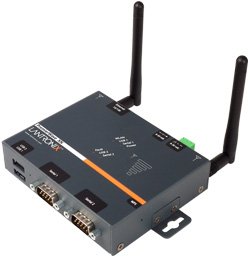A cable modem is a device that delivers high-speed Internet connectivity via a cable television company which serves as the Internet service provider (ISP). A cable modem requires a subscription to cable Internet service, and will not function by simply connecting it to a cable TV (CATV) feed. Externally, a cable modem resembles a DSL modem. The coax cable that brings in the digital CATV signal provides a channel for upstream and downstream Internet service. This does not interfere with television, as there is plenty of "real estate" or bandwidth space on the coax cable to handle both TV and Internet signals.
Often, a cable company offering Internet service will provide a cable modem to the subscriber. It may be provided free of charge to be returned at the end of the service contract, or there may be a small monthly equipment fee. In any case, the cable modem will be an external modem that has been pre-configured.
Alternately, a cable modem might be built-in to the set top box, or the unit that de-scrambles the cable signals. If a subscriber prefers, he or she can also purchase an internal or external cable modem, commonly available from computer retailers. CATV companies might provide a list of compatible manufacturers and instructions for configuring the cable modem, if required.
The advantage to purchasing a cable modem is that one can choose a model with the features desired. For example, a cable modem with a built-in networking switch and a router will allow the Internet connection to be shared with other computers throughout the house or office. Some models also come with a USB port for a quick and easy way to connect an additional computer that may not have an Ethernet port. This is especially handy for older laptops.
If a subscriber opts for a provided cable modem and it does not have a built-in switch and router, the subscriber will have to buy these devices separately in order to share the connection. The cost will likely be similar, or in some cases more, than buying a cable modem with the switch and router already built-in. Therefore, many people find it worth the small investment to purchase their own equipment.
Cable Internet service typically offers speeds of 1.5 megabits per second. Like DSL, it is an "always on" connection, but unlike DSL the cable subscriber does not have to be within short range of the home office. For this reason, cable Internet service is available in many regions where DSL is not.
One drawback of cable Internet service is that the speed is affected by how many people in the subscriber's immediate area are using the Internet service at once. Many people using the service simultaneously can saturate bandwidth resources, thereby slowing the connection to the cable modem. DSL is unaffected by this, as the subscriber uses his or her phone line for Internet service.
Cable modems are available everywhere computers are sold. If opting to buy your own modem, be sure it meets the requirements for your CATV service. If the connection will be shared over a network in the home or office, the type of network -- wired or wireless -- will also affect which type of modem you should buy.


No comments:
Post a Comment